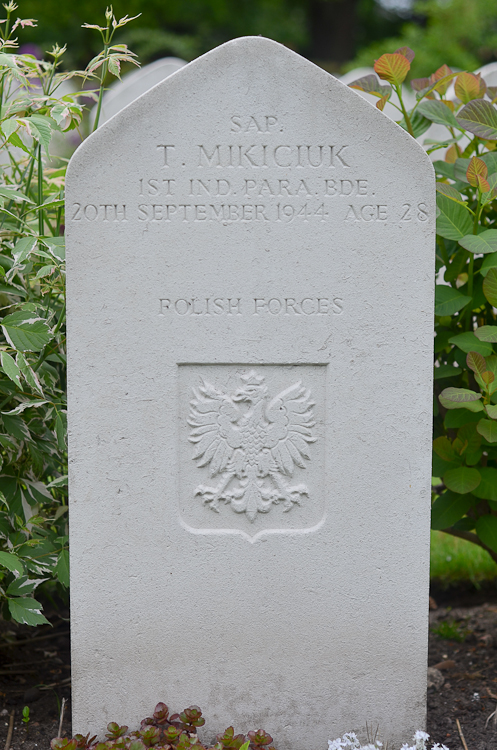Tadeusz Mikiciuk
Een graf in het Verenigd Koninkrijk op deze lijst? Met een Pool die om kwam in het VK? Bovendien ziet een oplettende lezer dat de naam van Tadeusz Mikiciuk ontbreekt op de namenlijst bij het monument in Driel. De reden is dat hij niet sneuvelde tijdens gevechtshandelingen in Oosterbeek of Driel. Hij heeft het vliegveld Spanhoe in Engeland nooit verlaten. Reden? Toen op 20 september het vertrekt naar Arnhem werd afgeblazen was de spanning voor hem te veel en heeft hij op het vliegveld zelfmoord gepleegd.
Hoewel niet omgekomen door gevechtshandelingen is tegenwoordig wel de consensus dat ook hij een slachtoffer is van de ‘Slag om Arnhem’. Voor ons de reden om hem toch op te nemen in deze lijst van oorlogsgraven. Zijn graf is te vinden op het Poolse deel van de begraafplaats van Newark upon Trent in het Verenigd Koninkrijk.
Zelfmoord en andere klachten
In 2016 schreef een Poolse medicus, Aleksander Rutkiewicz, in het Poolse ‘MILITARY PHYSICIAN’ een artikel met de titel: Four cases of stress disorders among Polish soldiers of the 1st Independent Parachute Brigade participating in Operation Market Garden, pagina 310-313 (Cztery przypadki zaburzeń stresowych wśród żołnierzy 1. Samodzielnej Brygady Spadochronowej uczestniczących w operacji „Market Garden”).
De vier gevallen zijn naast Mikiciuk nog korporaal Barkiet die op de Rijnoever zelfmoord pleegde toen de Polen pogingen ondernamen om de Rijn over te steken. De andere twee zijn met psychoneurotische klachten opgenomen in het ziekenhuis.
De zelfmoord van Mikiciuk
Rutkiewicz beschrijft in zijn paper pakkend de aanloop naar de zelfmoord van Mikiciuk op pagina 311 (overgenomen sept 2021):
Case 1. Suicide at the airfield
The plan for Operation Market Garden, the largest
airborne operation of World War II, assumed that the 1st
Independent Parachute Brigade would act jointly with the
British 1st Airborne Division. The objective was to capture
and secure bridges on the River Rhine in Arnhem. The
main forces of the Polish military unit were to be dropped
on the third day of the operation (the third air-drop), i.e.
on 19 September. On the first two days only the British
division was planned to land, partly due to the insufficient
number of military transport aircraft that could drop the
Polish and British soldiers. This meant that the forces had
to be dropped in stages, which later was considered to be
one of the reasons that the operation failed.
The weather was terrible on the day of the planned
take-off, the sky hidden by thick fog. In the morning,
trucks arrived at the Spanhoe and Saltby airfields
carrying the Polish paratroopers, who then began to jump
out. Grouped in sticks, they hurried towards the
sequentially-numbered aircraft. Next they waited for the
signal to put on their equipment and parachutes, and then
to board the aircraft. However, no such command was
given, and the flight time was delayed several times.
Finally, in the afternoon, a decision was made to cancel
the take-off due to the severe weather conditions. After
several hours of expectant waiting, the soldiers returned
to the garrison in a very bad mood, to spend the night
there.
Although the weather was still bad on 20 September
(Wednesday), the Polish troops once again arrived at the
airfields, hoping to take off. In the morning, the British
high command changed their order for the Polish brigade
and set a different landing zone. The plan that had been
meticulously created over many days was being turned
upside down, causing confusion among both the Polish
command and soldiers. Finally, around 13:00 hours, a
decision was made to take off. The paratroopers, each
carrying dozen kilograms or so of equipment, began to
clamber into the aircraft. The engines were started and
the American Dakota aircraft moved toward the take-off
line [3, 4]. Like any other take-off, the atmosphere could
not be tenser. Suddenly, the aircraft began to return to
the start line as the American crews were ordered to
discontinue the take-off. The weather was still bad and
the flight was put off for another 24 hours. The
paratroopers had to leave the aircraft, cursing. Some of
them had tears in their eyes. They probably realized that
on the following day they would have to go through the
same procedure once again, while they had hoped to “get
it over” as soon as possible. It was reported that the
Polish soldiers were so emotional that some of the
American aircrew tried to avoid them as much as possible
[4].
Eventually, one of the Poles could no longer bear the
tension. He took out his gun, pointed it at his own head
and fired. He died instantly. This was Spr. Tadeusz
Mikiciuk from the parachute sapper company [5, 6]. The
statistical and descriptive report regarding the brigade’s
health service activities included the laconic remark: “Spr
MikiciukTadeusz – on 29.09.44. shot himself at the
airfield” [6]. Spr Mikiciuk was buried at the Polish War
Graves Cemetery in Newark-on-Trent, England [7].


